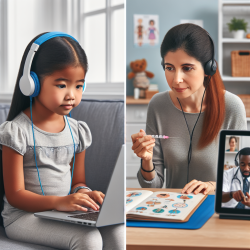Unlocking the Secrets of Frequency-Limiting Effects for Better Therapy Outcomes
As a special education director, you're always on the lookout for ways to enhance the educational experience for students with special needs. A recent study titled "Frequency-Limiting Effects on Speech and Environmental Sound Identification for Cochlear Implant and Normal Hearing Listeners" offers valuable insights that can transform your approach to therapy sessions, especially for students with cochlear implants (CI).
Understanding Frequency-Limiting Effects
The study, conducted by Chang et al., investigates how frequency-limiting effects impact the identification of speech and environmental sounds by individuals with cochlear implants compared to those with normal hearing. The researchers explored how low-pass and high-pass filtering of acoustic signals affects the ability to identify Korean vowels, consonants, and various environmental sounds.
Key Findings and Implications
- Similar Patterns, Different Efficiencies: Both CI and normal hearing (NH) subjects showed changes in identification performance based on cutoff frequencies. However, CI users were generally less efficient in utilizing limited spectral information due to the coding inefficiencies of CI sound processors.
- Importance of Frequency Bands: The study highlights the critical role of frequency bands, particularly between 1-2.5 kHz, in conveying phonetic cues essential for speech intelligibility.
- Environmental Sound Identification: The research indicates that CI users may rely more on temporal cues for environmental sound identification, while NH listeners benefit from both spectral and temporal cues.
How Practitioners Can Apply These Insights
As a practitioner, you can leverage these findings to enhance therapy sessions for students with cochlear implants. Here are some actionable steps:
- Focus on Critical Frequency Bands: Tailor auditory training sessions to emphasize frequency bands that are most crucial for speech and environmental sound identification.
- Incorporate Environmental Sounds: Use a variety of environmental sounds in therapy sessions to help students improve their identification skills, which may also enhance their speech perception abilities.
- Customize Training Approaches: Recognize the unique challenges faced by CI users and customize training programs to address these specific needs, focusing on both spectral and temporal cues.
Encouraging Further Research
While this study provides valuable insights, it also opens the door for further research. Practitioners are encouraged to explore additional studies that delve into the nuances of frequency-limiting effects and their implications for different languages and sound processing strategies.
By staying informed and continuously adapting your approach based on the latest research, you can ensure that your students receive the most effective therapy possible.
To read the original research paper, please follow this link: Frequency-Limiting Effects on Speech and Environmental Sound Identification for Cochlear Implant and Normal Hearing Listeners.










